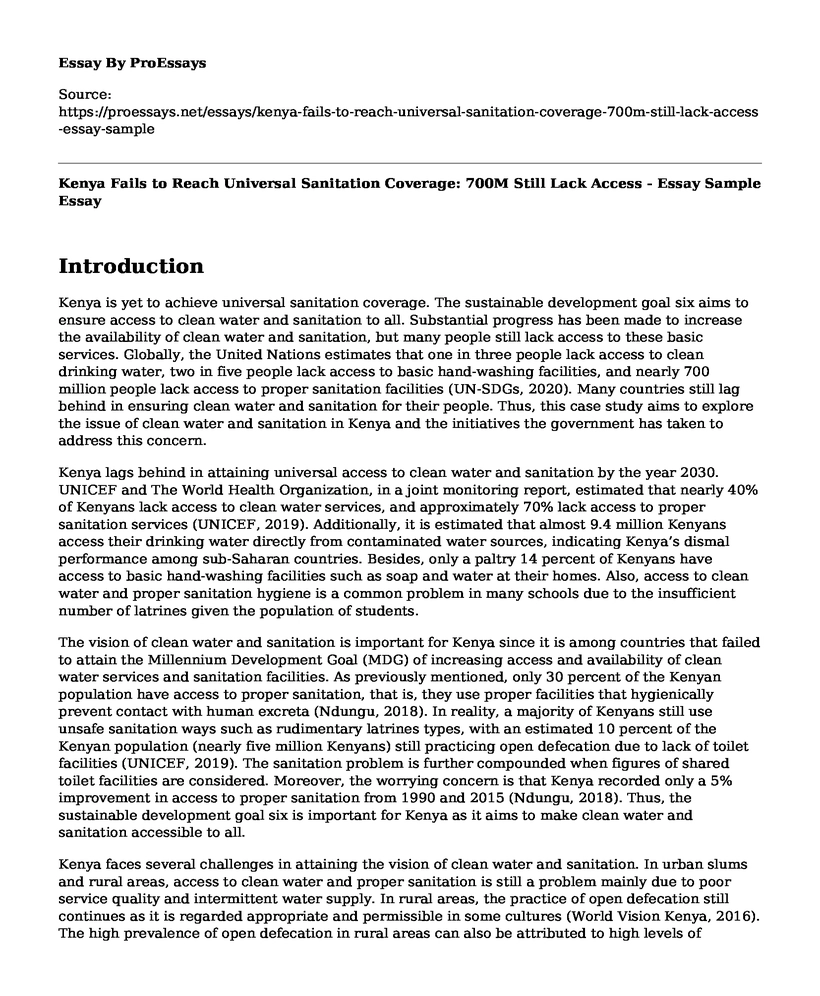Introduction
Kenya is yet to achieve universal sanitation coverage. The sustainable development goal six aims to ensure access to clean water and sanitation to all. Substantial progress has been made to increase the availability of clean water and sanitation, but many people still lack access to these basic services. Globally, the United Nations estimates that one in three people lack access to clean drinking water, two in five people lack access to basic hand-washing facilities, and nearly 700 million people lack access to proper sanitation facilities (UN-SDGs, 2020). Many countries still lag behind in ensuring clean water and sanitation for their people. Thus, this case study aims to explore the issue of clean water and sanitation in Kenya and the initiatives the government has taken to address this concern.
Kenya lags behind in attaining universal access to clean water and sanitation by the year 2030. UNICEF and The World Health Organization, in a joint monitoring report, estimated that nearly 40% of Kenyans lack access to clean water services, and approximately 70% lack access to proper sanitation services (UNICEF, 2019). Additionally, it is estimated that almost 9.4 million Kenyans access their drinking water directly from contaminated water sources, indicating Kenya’s dismal performance among sub-Saharan countries. Besides, only a paltry 14 percent of Kenyans have access to basic hand-washing facilities such as soap and water at their homes. Also, access to clean water and proper sanitation hygiene is a common problem in many schools due to the insufficient number of latrines given the population of students.
The vision of clean water and sanitation is important for Kenya since it is among countries that failed to attain the Millennium Development Goal (MDG) of increasing access and availability of clean water services and sanitation facilities. As previously mentioned, only 30 percent of the Kenyan population have access to proper sanitation, that is, they use proper facilities that hygienically prevent contact with human excreta (Ndungu, 2018). In reality, a majority of Kenyans still use unsafe sanitation ways such as rudimentary latrines types, with an estimated 10 percent of the Kenyan population (nearly five million Kenyans) still practicing open defecation due to lack of toilet facilities (UNICEF, 2019). The sanitation problem is further compounded when figures of shared toilet facilities are considered. Moreover, the worrying concern is that Kenya recorded only a 5% improvement in access to proper sanitation from 1990 and 2015 (Ndungu, 2018). Thus, the sustainable development goal six is important for Kenya as it aims to make clean water and sanitation accessible to all.
Kenya faces several challenges in attaining the vision of clean water and sanitation. In urban slums and rural areas, access to clean water and proper sanitation is still a problem mainly due to poor service quality and intermittent water supply. In rural areas, the practice of open defecation still continues as it is regarded appropriate and permissible in some cultures (World Vision Kenya, 2016). The high prevalence of open defecation in rural areas can also be attributed to high levels of poverty. The high rate of population growth in Kenya is also a significant challenge as it has outstripped the provision of essential water and sanitation services. In urban places, poor urban planning and waste management exacerbate the problem further. If the current challenges persist, Kenya may take longer to attain universal sanitation coverage.
A paradigm shift of strategies is necessary if Kenya is to achieve the sustainable development goal number six by the year 2030. As such, the government developed the ‘Kenya Environmental Sanitation and Hygiene Strategic Framework’ (KESSF) to facilitate proper sanitation (Ministry of Health, 2016). The KESSF is aligned with the Kenya Health Policy that targets the highest level of health attainable in a middle-income economy. Essentially, the KESSF provides a blueprint for the implementation of policies that aims at increasing the percentage of Kenyans with access to proper sanitation to 100 percent by the year 2030. Also, the KESSF seeks to ensure the progressive fulfillment of the right to basic clean water and sanitation services for every person, as guaranteed in the Kenyan Constitution.
However, as previously mentioned, Kenya faces several challenges that jeopardize the effectiveness of the KESSF framework. Thus, it is crucial to review the existing legislation, policies, and regulations at both levels of government to achieve a multi-sectoral intervention approach. Besides, sanitation financing will require to be increased to subsidize targeted interventions in both urban and rural areas. Finally, the KESSF framework will only be effective if community consultation and stakeholder engagement are enhanced as this will assure the sustainability of the proposed sanitation interventions.
References
Ministry of Health. (2016). Kenya Environmental Sanitation and Hygiene Strategic Framework (KESSF).
Ndungu, P. (2018). Why Kenya's Sanitation Challenge Requires Urgent Attention. World Bank Blogs. Retrieved from https://blogs.worldbank.org/africacan/why-kenyas-sanitation-challenge-requires-urgent-attention/
UNICEF. (2019). Improving Water, Sanitation, and Hygiene in Kenya. UNICEF. Retrieved from https://www.unicef.org/kenya/water-sanitation-and-hygiene/
UN-SDGs. (2020). Goal 6: Clean Water and Sanitation. United Nations. Retrieved from https://www.un.org/sustainabledevelopment/water-and-sanitation/
World Vision Kenya. (2016). Access To Toilets Needs To Be A Priority In Kenya. World Vision Kenya. Retrieved from https://www.wvi.org/kenya/article/access-toilets-needs-be-priority-kenya/
Cite this page
Kenya Fails to Reach Universal Sanitation Coverage: 700M Still Lack Access - Essay Sample. (2023, Aug 14). Retrieved from https://proessays.net/essays/kenya-fails-to-reach-universal-sanitation-coverage-700m-still-lack-access-essay-sample
If you are the original author of this essay and no longer wish to have it published on the ProEssays website, please click below to request its removal:
- Protect Yourself Against HPV Essay
- Diet Versus Exercise Essay Example
- Literary Analysis Essay on Notes From Underground by Fyodor Dostoyevsky
- Heartland Hospital Patient-Centered Initiative Evaluation
- Essay Sample on Preventing the Next Opioid Crisis: Solutions & Opposing Arguments
- Essay on Infection Control: A Cross-Sectional Study of Staff Compliance and Education
- Essay Example on Genetically Modified Foods: Benefits for Global Food Security







